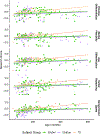Distinct neurocognitive profiles and clinical phenotypes associated with copy number variation at the 22q11.2 locus
- PMID: 37997544
- PMCID: PMC10872774
- DOI: 10.1002/aur.3049
Distinct neurocognitive profiles and clinical phenotypes associated with copy number variation at the 22q11.2 locus
Abstract
Rare genetic variants that confer large effects on neurodevelopment and behavioral phenotypes can reveal novel gene-brain-behavior relationships relevant to autism. Copy number variation at the 22q11.2 locus offer one compelling example, as both the 22q11.2 deletion (22qDel) and duplication (22qDup) confer increased likelihood of autism spectrum disorders (ASD) and cognitive deficits, but only 22qDel confers increased psychosis risk. Here, we used the Penn Computerized Neurocognitive Battery (Penn-CNB) to characterized neurocognitive profiles of 126 individuals: 55 22qDel carriers (MAge = 19.2 years, 49.1% male), 30 22qDup carriers (MAge = 17.3 years, 53.3% male), and 41 typically developing (TD) subjects (MAge = 17.3 years, 39.0% male). We performed linear mixed models to assess group differences in overall neurocognitive profiles, domain scores, and individual test scores. We found all three groups exhibited distinct overall neurocognitive profiles. 22qDel and 22qDup carriers showed significant accuracy deficits across all domains relative to controls (episodic memory, executive function, complex cognition, social cognition, and sensorimotor speed), with 22qDel carriers exhibiting more severe accuracy deficits, particularly in episodic memory. However, 22qDup carriers generally showed greater slowing than 22qDel carriers. Notably, slower social cognition speed was uniquely associated with increased global psychopathology and poorer psychosocial functioning in 22qDup. Compared to TD, 22q11.2 copy number variants (CNV) carriers failed to show age-associated improvements in multiple cognitive domains. Exploratory analyses revealed 22q11.2 CNV carriers with ASD exhibited differential neurocognitive profiles, based on 22q11.2 copy number. These results suggest that there are distinct neurocognitive profiles associated with either a loss or gain of genomic material at the 22q11.2 locus.
Keywords: 22q.11.2 deletion syndrome; 22q11.2 duplication; Velocardiofacial syndrome; cognition; copy number variation; intellectual ability; memory; psychopathology; psychosis; social function.
© 2023 The Authors. Autism Research published by International Society for Autism Research and Wiley Periodicals LLC.
Figures




Update of
-
Distinct Neurocognitive Profiles and Clinical Phenotypes Associated with Copy Number Variation at the 22q11.2 Locus.medRxiv [Preprint]. 2023 May 16:2023.05.12.23289905. doi: 10.1101/2023.05.12.23289905. medRxiv. 2023. Update in: Autism Res. 2023 Dec;16(12):2247-2262. doi: 10.1002/aur.3049. PMID: 37292882 Free PMC article. Updated. Preprint.
References
-
- Achenbach TM (1999). The Child Behavior Checklist and related instruments. The Use of Psychological Testing for Treatment Planning and Outcomes Assessment, 2nd Ed., pp. 429–466. Mahwah, NJ, US: Lawrence Erlbaum Associates Publishers.
-
- Achenbach TM, & Rescorla LA (2001). Manual for the ASEBA school-age forms & profiles: child behavior checklist for ages 6–18, teacher’s report form, youth self-report: an integrated system of multi-informant assessment. University of Vermont, research center for children youth & families.
-
- Antshel KM, Shprintzen R, Fremont W, Higgins AM, Faraone SV, & Kates WR (2010). Cognitive and psychiatric predictors to psychosis in velocardiofacial syndrome: a 3-year follow-up study. Journal of the American Academy of Child and Adolescent Psychiatry, 49(4), 333–344. Retrieved from https://www.ncbi.nlm.nih.gov/pubmed/20410726 - PMC - PubMed

